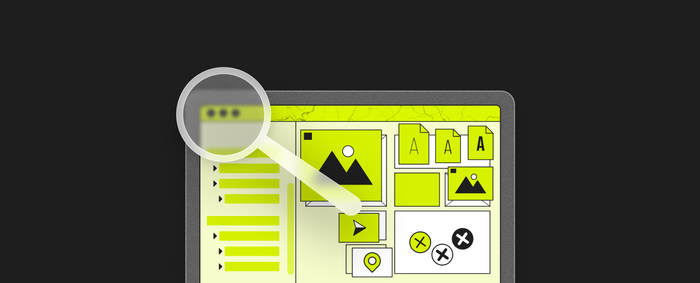What is digital accessibility?

Imagine you are trying to catch up on some important news online, but the website’s text is so small and hardly distinguishable from the background that it’s nearly impossible to read. This isn’t a rare case - it’s a reality for millions of people who face digital barriers daily, simply because websites and apps aren’t created with accessibility in mind. In this article, we’ll explain the basics of digital accessibility, explore key terms and issues, and explain why ensuring equal access is not only a legal and ethical requirement but also a smart business strategy that enhances usability, SEO, and overall satisfaction of all users.
28 March 2025
Aleksandra Michalska
UX/UI Designer
Table of Contents:
Digital accessibility
Digital accessibility is the practice of designing, developing and adapting digital products, content, technologies, and resources to ensure they are usable by all users, including those with disabilities. It eliminates barriers and ensures that websites, applications, and online services are functional, understandable, and easy to use for all individuals regardless of their physical, sensory, or cognitive abilities.
By following global accessibility standards such as WCAG, various platforms and resources can become more inclusive, allowing all users to access, interact with, and contribute to the digital environment.
Why is digital accessibility important?
Ensuring accessibility benefits both users and businesses by enhancing usability, customer reach, and brand reputation. Digital accessibility is a complex, multifaceted concept that goes way beyond meeting technical standards. Here are the key advantages of digital accessibility:
- Social and ethical responsibility
Digital accessibility is not only a necessity but also a fundamental human right. It affects individuals' sense of belonging. By removing digital barriers, accessibility fosters social inclusion, independence and equal opportunities, reducing discrimination against those at risk of digital exclusion. - Enhanced user experience and usability
Accessibility-focused design positively impacts overall user experience. Accessible solutions improve usability for all users, not just those with specific needs. Adapting web content to a variety of input and output devices (assistive technology tools such as screen readers, voice recognition, eye trackers, witch devices ) or even browsers, allows users to choose a convenient form of access, making their experience more personalized. - Cost reduction in customer support, development and maintenance
More accessible websites reduce the need for direct customer support by enabling users to complete tasks independently. Projects that are created with accessibility in mind from the beginning are easier to maintain and update, reducing long-term development costs. - Impact on SEO and visibility in search results
Many accessibility guidelines overlap with best SEO practices. The implementation of accessibility standards can contribute to a higher position in the organic search results, which promotes easier acquisition of new customers, prolonging the time spent by users on the site, resulting in increased conversions, thus achieving better results. It provides a competitive advantage by increasing reach and attracting a wider potential customer base. - Legal compliance and risk mitigation
In many countries, digital accessibility is a legal requirement. Non-compliance can lead to legal action, fines, and reputational damage. Implementing accessibility may protect organizations from legal risks and accusations of discrimination. - Competitive Business Benefits
Accessibility can become a standout factor for a site against its competitors. Investing in accessibility allows you to increase credibility with your brand and create positive feelings among consumers, which also strengthens corporate social responsibility (CSR) efforts.
Digital Accessibility Laws and Compliance
Digital accessibility is regulated by multiple laws worldwide. These legal acts aim to ensure equal access, protect users from digital exclusion and discrimination while encouraging organizations to innovate in their accessibility efforts. Some organizations failing to comply with accessibility standards in their digital products may face lawsuits, fines, and reputational damage.
Key digital accessibility regulations:
- European Accessibility Act (EAA) – establishes accessibility requirements for digital products and services in the EU.
- EN 301 549 – a European standard defining accessibility requirements for ICT products and services.
- UK Equality Act 2010 – prohibits discrimination, including inaccessible digital content, in the UK.
- Americans with Disabilities Act (ADA) – requires businesses in the U.S. to ensure accessibility for individuals with disabilities.
- Section 508 of the Rehabilitation Act – mandates that U.S. federal agencies make digital content accessible.
Common Barriers to Digital Accessibility
As websites and digital platforms become more complex, ensuring accessibility remains a growing challenge. The WebAIM Million report, published annually, analyzes accessibility issues across the top 1 000 000 web sites. The 2024 report shows that the most common WCAG failures (detected automatically) include: low text contrast, lack of alternative text for images, missing form input labels, empty links and buttons and lack of document language specification.
There are multiple factors that can become a barrier to a digital accessibility, beyond the technical issues. One of the key factors is lack of awareness about accessibility among content and digital product creators. Environmental factors include external conditions such as bright sunlight, noisy environments, lack of IT infrastructure or slow internet connections can emphasize accessibility issues. Old devices can no longer receive updates and may become unstable and insecure, exposing users to cybersecurity risks. It may become incompatible with some applications after their update, preventing users from accessing essential services. Language barriers create significant obstacles for many users when accessing digital content. While English is widely used online, not all users understand it, and many websites do not provide translations into other languages.
Digital exclusion
The opposite of accessibility is digital exclusion, which refers to the barriers preventing individuals or groups from accessing, using, or benefiting from digital technologies. These barriers can be economic, educational, technological, or social, making it difficult for people to participate fully in the digital world. It is a form of social exclusion that affects an increasing number of people as technology advances. The digital divide describes the gap between individuals who have access to information technology and those who do not. Digital poverty is the inability to access or afford essential digital technology, including devices, the internet, and software. It affects people’s ability to work, study, or engage with online services, worsening social and economic inequalities.
People who are most vulnerable to digital exclusion include:
- people with disabilities (about 16% of the global population according to WHO) - many digital services fail to support assistive technologies.
- elderly individuals - may not be skilled in the use of technology or struggle with age-related impairments such as poor vision or hearing.
- low-income individuals - the high cost of new devices, software and internet services prevent them from accessing essential digital resources.
- people in rural and remote areas - lack of proper infrastructure, slow or no internet connectivity limits access to online services.
- individuals with low digital literacy - some people do not know how to use digital services or feel overwhelmed by it.
- non-native speakers - language barriers make it difficult to access online content, digital services, and learning platforms.
Implementing Accessibility in Web and App Design
Integrating accessibility into the web and app design process requires a structured approach that considers diverse user needs from the start. Accessibility should not be an afterthought but a core principle throughout the entire design and development process. Several design methodologies emphasize accessibility and inclusivity:
- inclusive design,
- user-centered design (UCD),
- design thinking
Based on the principles described in Just Ask: Integrating Accessibility Throughout Design by Shawn Lawton Henry, accessibility should be considered at every stage of the design and development process:
Research & Planning
- Understand the needs of users with disabilities.
- Conduct accessibility audit of existing product.
- Identify compliance requirements (e.g., WCAG).
Wireframing & Prototyping
- Ensure that the design meets the accessibility standards and compliance requirements.
- Provide keyboard-friendly navigation and focus indicators.
- Test the design with plugins and assistive technologies.
Development
- Implement semantic HTML and ARIA roles for dynamic elements.
- Ensure all interactive elements are fully operable via keyboard and voice commands.
- Optimize performance.
Testing & Iteration
- Conduct usability testing with real users, including those with disabilities.
- Use automated tools (e.g., WAVE, Axe) alongside manual testing.
- Gather feedback and continuously improve accessibility features.
International Standards and Guidelines
The digital space is one of the few areas with defined and standardized accessibility guidelines. The World Wide Web Consortium (W3C) established global web accessibility standards for various web components. Those key standards include:
- WCAG 2.2 (Web Content Accessibility Guidelines) – defines accessibility principles for websites and digital content.
- ATAG 2.0 (Authoring Tool Accessibility Guidelines) – ensures that content creation tools support accessibility.
- UAAG (User Agent Accessibility Guidelines) – focuses on improving accessibility in web browsers and media players.
W3C also developed the ARIA (Accessible Rich Internet Applications) specification, which enhances the accessibility of dynamic elements and user interface components built with HTML, JavaScript, and AJAX. By following these standards, digital products can become more inclusive and user-friendly for people with diverse abilities.
Digital Accessibility Testing
The process of evaluating digital content, to ensure that it is accessible to all users, including people with disabilities is crucial and needs to be carried out at the early stages of the design process. It involves checking compliance with accessibility standards and guidelines, identifying barriers that may prevent users from accessing content, and providing suggestions for adjustments to enhance usability.
The most effective approach to a11y testing includes a blend of three methods: automated testing using checking tools, manual testing by accessibility experts, and user testing with people with disabilities. Automated tools can quickly identify most of the accessibility issues, while manual testing allows for a more nuanced understanding of user experience. User testing provides direct feedback from those who rely on assistive technology, ensuring that the content meets their needs effectively.
Design tools like Figma offer a wide range of accessibility plugins that help designers easily evaluate color contrast, text legibility, and keyboard navigation without leaving their workspace. This allows teams to build accessibility into their workflow from the very beginning. Tools like WAVE, Axe, and Lighthouse scan websites for WCAG compliance, highlighting missing alt text, contrast problems, and structural issues. These tools save time by identifying many problems instantly, but they can’t replace manual testing or user feedback.
The Future of Digital Accessibility
Digital accessibility is changing with AI, automation, and new interaction methods like voice control and gesture navigation. AI is improving real-time captioning, alt text, and personalized experiences, making digital content more inclusive. Inclusive design is becoming a standard, integrating accessibility in all stages of development. Machine learning helps in detecting and fixing barriers faster, making audits and adaptive technologies more effective. More restrictive regulations and growing awareness are pushing businesses to prioritize accessibility. The future is about creating a digital world a place where everyone, regardless of their ability, can participate equally.
The future of accessibility isn’t merely about removing barriers—it’s about creating a digital environment where everyone, regardless of ability, can participate equally. With continuous technological progress, collaboration between industries, and the integration of accessibility-first design, the next generation of digital products will be more adaptable, intuitive, and universally usable.

